"We are what we repeatedly do. Excellence, then, is not an act, but a habit." --Aristotle
Address any questions or comments regarding this newsletter to the individual authors listed after each article or to its editor, Rick Weinzierl, 217-333-6651, weinzier@illinois.edu. To receive e-mail notification of new postings of this newsletter, call or write the same number or address.
In This Issue:
Degree-Day Calculator Site Up and Running Again
Regional Updates (from Dixon Springs, southern Illinois, and western Illinois)
Notes from Chris Doll (dry conditions, calcium supplements, early harvests, Ethrel)
For Fruit and Vegetable Growers (potato leafhopper, Japanese beetle)=)
Fruit Production and Pest Management (dark-winged fungus gnat larvae in strawberries, nutrient deficiencies, GAP and HACCP reminders, notes on oriental fruit moth and codling moth)
Vegetable Production and Pest Management (beet leafhopper in horseradish)
June MarketMaker Newsletter (June newsletter now available)
Degree-Day Calculator Site Up and Running Again
The Degree-Day Calculator site managed by the Illinois State Water Survey is again up and running at http://www.isws.illinois.edu/warm/pestdata/. Click on “Calculator” in the box at the upper right, then choose a pest from the list and the location nearest you. After the program generates cumulative degree-days, most displays include a link to information on pest development related to degree-days. Background information on degree-days and pest development is available at http://ipm.illinois.edu/degreedays/index.html.
Upcoming Programs
- Openfields Farm Tour, Jo Daviess, Stephenson and Winnebago Counties, June 10, 2012, noon – 4:00 p.m. University of Illinois Extension invites you (and your family) to take part in the 4th Annual Openfields Farm Tour. Pick and choose your destinations on this no cost, self-guided tour of local farms, fields, and gardens in northern Illinois. Meet local producers and learn about locally grown food. For more information, see http://web.extension.illinois.edu/units/event.cfm?EventID=58182&UnitID=462.
- High Tunnel Workshop, June 11, 2012. Workforce Careers Center, Lincoln Land Community College, 9:00 a.m. to 4:30 p.m. Mike Bollinger and local growers will cover developing a planting plan, planting, and management topics including insect and weed control and winter growing. Registration is $30. (A discounted rate of $50 will be charged to participants who sign up for this and the May 12 workshop listed above.) Registration includes a box lunch and copies of two books, The Polytunnel Handbook and The Winter Harvest Handbook. For more information and to register, see www.llcc.edu/greencenter or contact Julie Bates at julie.bates@llcc.edu or 217.786.2434. Hosted in conjunction with University of Illinois Extension and funded with the assistance of the Illinois Community College Board and the Illinois Department of Commerce and Economic Opportunity.
- Illinois Summer Horticulture Day, June 14, 2012, at Kuipers Family Farm near Maple Park, Illinois. Kuipers’ Family Farm features a pick-your-own orchard and pumpkin shop, a bakery, a Barn Store, and many entertainment activities. For more information, see www.kuipersfamilyfarm.com or www.specialtygrowers.org. For reservations, use www.ilsthortsoc@yahoo.com or call 309-828-8929.
- From Garden Gates to Dinner Plates, June 20, 2012, 9:00-11:00 a.m. and 6:00-8:00 p.m. at the University of Illinois Extension, Dewitt County Office, 8425 Katie Road, Clinton. Register at https://webs.extension.uiuc.edu/registration/?RegistrationID=6785 or contact Lynnette Mensah at lmensah@illinois.edu or call 217-877-6042.
- Openfields Farm Tour, Logan, Menard, and Sangamon Counties, June 24, 2012, noon – 4:00 p.m. University of Illinois Extension invites you (and your family) to take part in the 1st Annual Openfields Farm Tour. Pick and choose your destinations on this no cost, self-guided tour of local farms, fields and gardens in central Illinois. Meet local producers and learn about locally grown food. For more information, see http://web.extension.illinois.edu/units/event.cfm?UnitID=483&EventID=58224
- Is Entrepreneurial Farming for You?, July 26, 2012, 5:30 – 9:00 p.m. at the University of Illinois Extension Office in Springfield. A workshop to provide assistance to aspiring farmers with new business ideas. For more information and to register, see https://webs.extension.uiuc.edu/registration/?RegistrationID=6818 or contact Deborah Cavanaugh-Grant at cvnghgrn@illinois.edu or call 217-782-4617.
- Introduction to Vegetable Diseases, June 26 and 27, 2012, 6:00-8:00 p.m., at the University of Illinois Extension Office in Monmouth, IL. These sessions will deal with the general principles of the causes, diagnosis, and control of vegetable crop diseases primarily for market vegetable producers. For more information and to register, see https://webs.extension.uiuc.edu/registration/?RegistrationID=6866 or contact Kyle Cecil at cecil@illinois.edu or 309-342-5108.
Regional Updates
At the Dixon Springs Agricultural Center ... three summer interns from the University of Illinois have begun projects sponsored by the Office of Research in the College of ACES.
Amanda Rosendale, a junior in Food Science and Human Nutrition with a concentration in Food Industry and Business will conduct a research project exploring the incorporation of locally grown produce into school meal programs. With the passage of the Local Foods, Farms, and Jobs Act, Public Act 096-0579, it is important to begin bridging the gap between local farms and schools, and that is the main objective of her research. By surveying schools and specialty crops farmers in the Delta Regional Authority of Illinois, she will determine the interest, concerns, and capabilities of having locally grown produce in school meal programs and also of participation in the Illinois Farm to School program. She hopes to help bridge the gap between schools and local producers, help schools to offer more nutritious fruits and vegetables to students, and strengthen the economy of the Delta Regional Authority area of southern Illinois.
Michael Fornaris is studying Food Science and Human Nutrition, and at Dixon Springs he is evaluating eight raspberry cultivars to find out if there is a correlation between cultivar and nutrient density. His experiment will also include observations of yield, pH, mass, diameter, phenolic compounds, and vitamin C. Michael intends that this work will provide results that are important to both farmers and consumers who more and more concerned with health and nutrition, especially the antioxidant power of berries. He is working with Dr. Nikki Engeseth, a food science professor, and horticulturist Jeff Kindhart. His plan is that the results of this study can spark further research on the effects of cultivation and growing methods on the nutritional properties of brambles.
Vivian Lau is a junior studying Food Science and Human Nutrition, with a concentration in Dietetics. At Dixon Springs she will be studying the effect of different varieties, planting media, and environment on the nutrient density of strawberries. The purpose of her project is to determine how different factors can affect the nutrient density of the fruit. She is examining the impact of different media and cultivar selection on nutrient density and yield of strawberries grown hydroponically in a vertical stacking system in a high tunnel. The findings of this research may enhance our understanding of ways to increase nutrient density of foods. As society is becoming more nutrition-conscience, it is important to find ways to obtain nutrient-dense foods, especially for populations that need more nutrition but have trouble getting an adequate amount from their diet, such as the elderly. Her findings may help enhance profitability for growers and may also help them raise a more nutrient-dense product to benefit consumers.
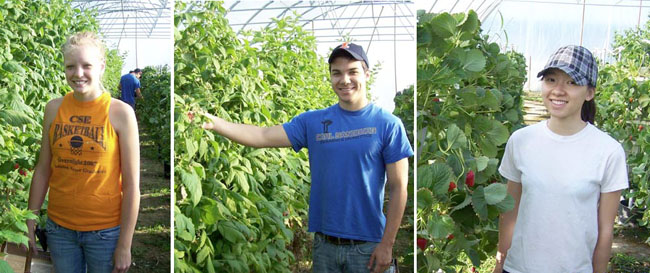
University of Illinois interns at the Dixon Springs Agricultural Center: (left to right) Angela Rosendale, Michael Fornaris, and Vivian Lau.
Jeff Kindhart (618-695-2770; jkindhar@illinois.edu)
In southern Illinois overall ... much of the region is running dry, with many areas running at a deficit against the 30-year average.
Early peach harvest has begun in the southern region. Though not widespread in the southern region, signs of frost injury are evident in low areas. With fruit sizing, it is more obvious which fruit sustained damage. Cut peaches that sustained injury show a definite brown seed inside the pit. The injured apples I have cut usually have a low seed count and have a slowed and/or unusual growth rate. Much of the injured fruit will fall from trees before harvest.

Left: frost injury on apple. One apple is ribbed, the other has distorted growth (both are low-seeded). Right: frost injury on peach. The peach on the right has a healthy seed in the pit; the peach on the right has a dead (brown) seed in the pit--notice reduced size.
Grapes have made a fairy good rebound from having the primary growth burned back by frost. Vineyards have already made the first pass on shoot thinning, vine training, and some amount of crop adjustment. Though the critical control period for fruit infection of black rot and Phomopsis has passed, remember a healthy canopy is needed to ripen the crop properly and build reserves for winter survival. Phomopsis is still a concern in terms of rachis and shoot infection, plus powdery mildew throughout the season and downy mildew later in the season. Japanese beetles have been reported throughout the region, so attention should be paid to the level of feeding on leaves. Vines can take some feeding, but if damage is left unchecked, it can reduce berry quality.
Summer raspberry harvest is already finishing, while blackberries are ripening. As with grapes, scouting blackberries for Japanese beetle is needed to avoid fruit feeding and overfeeding on leaves.
Sweet corn harvest has begun ... not so amazing considering the first planting I heard about went in on March 10.
Elizabeth Wahle (618-344-4230; wahle@illinois.edu)
In western Illinois ... Weather has been good around the area, with a few rain showers during the week of May 28. The Galesburg area received 1 inch to 1.25 inches. Soil moisture is adequate here at this time. We all hope that we receive timely rains throughout the rest of the season. We had our first taste of very warm weather Memorial Day weekend, with temps in the 90's.
A recent informal survey of blackberries throughout the area indicates a tremendous crop is developing. Flavor and sugars will increase as the fruit grows over the coming weeks. About 85 percent of the fruit size is gained in the last days of maturation. Development at this time depends on adequate supplies of carbohydrates and water; any limitation will adversely affect the size of fruit ... so growers who can irrigate should do so when needed.
Kyle Cecil (309-342-5108; cecil@illinois.edu)
Notes from Chris Doll
Naturally, talk continues about the weather. Now it is the lack of rain. Two weeks ago, southern Illinois growers reported a 10-inch deficit for 2012, and it has not changed any since then. In the SW corner of the state, I've had 0.7 inch of rain in the last four weeks, which makes it dry for almost everything. Twelve- to twenty-inch-high corn is rolling even on low 80-degree days. Non-irrigated plantings of small fruit crops and first year trees appear to need water, and older tree fruits won’t be far behind if June rains are tardy.
This kind of weather slows uptake of calcium into fruit via the soil solution, so the addition of a calcium supplements in cover sprays most likely is needed. There are cautions about getting accumulations of too much calcium chloride on leaves to the point of causing some injury. I've only seen that a couple of times during extended droughts and perhaps when overdosing did occur.
The local season continues to be over 14 days ahead of 2011 based on my observations. Some peaches were marketed over the Memorial Day weekend, and today I saw one variety near full maturity and another close behind. A couple of Lodi apple trees in a hobby orchard nearby look ready for harvest, with lots of fruit already on the ground. The black raspberry harvest is over, red raspberries and blueberries are near mid-season. Blackberries are not far behind, with Triple Crown showing red fruits.
The anticipated emergence of Japanese beetles was not as early as I predicted last time. But the absence of seeing any on my wife's yellow roses still made me put out a trap two days ago, and the result was a 1/4 cup of adults. No feeding on Honeycrisp or grapes has been seen yet. Other insect pests on fruit crops have been relatively minor in scope, with reports of some red mite control being needed, and a local orchard had significant feeding by the potato leaf hopper. Fire blight infections happened through the last rain, but no trauma blight has been seen. Bacterial spot of peach was prevalent early in the spraying season, but control has been effective or seasonal decline has set in.
The mention of using Ethrel for late thinning and repeat bloom in apples in my recent notes started a discussion on its usage with a couple of growers. No changes in that regard, but I had to check my files for accuracy. The file included copies of a Michigan State newsletter dated August 7, 1973 and a New York Extension Service Spray Letter dated August 9, 1973 about the use of Ethrel for hastening fruit maturity and increasing skin color for early harvesting. It seems to be quite a durable product that still has benefits.
Chris Doll
For Fruit and Vegetable Growers
Potato Leafhopper
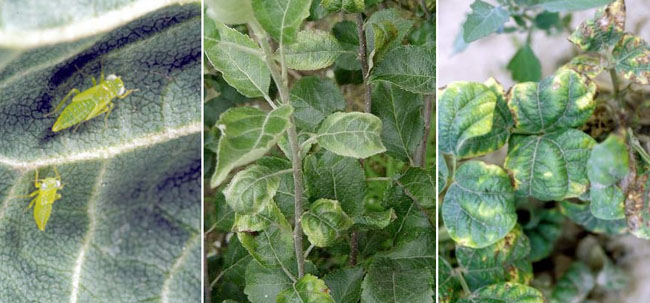
Potato leafhopper nymphs (Purdue Univ.) and injury to apple (Michigan State Univ.) and green beans (Univ. of Minnesota).
Potato leafhopper is present throughout the state. This insect feeds on a wide range of annual and perennial plants, including potatoes, green beans, apples, maples, and redbuds. As it feeds, it secretes a salivary enzyme that kills cells and causes distorted growth and reduction in growth and yield. In apples, it’s most common in young plantings not often treated for other pests because they are not yet fruiting, but it also occurs in blocks where spray programs have been reduced because of freeze damage and in blocks where selective insecticides used against codling moth (such as Altacor, Delegate, and Rimon) do not control it. Consult the 2012 Midwest Vegetable Production Guide and the 2012 Midwest Tree Fruit Spray Guide for effective insecticides labeled for specific crops.
Rick Weinzierl (217-244-2126; weinzier@illinois.edu)
Japanese Beetle
As Chris, Elizabeth, and others have noted, Japanese beetle emergence has begun in the southern part of the state. This insect will begin emerging in more northern locations soon, and it feeds on a wide range of crops. In many crops, Sevin or a pyrethroid insecticide is an effective choice for control. Imidan and Assail are effective against it in tree fruits. Consult the 2012 Midwest Vegetable Production Guide and the 2012 Midwest Tree Fruit Spray Guide for effective insecticides labeled for specific crops.
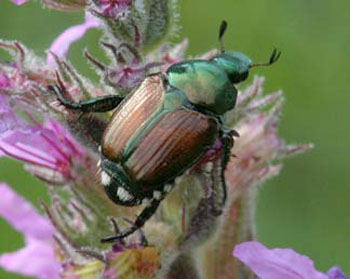
Japanese beetle (photo by Whitney Cranshaw).
Rick Weinzierl (217-244-2126; weinzier@illinois.edu)
Fruit Production and Pest Management
Dark-winged Fungus Gnat in Strawberries
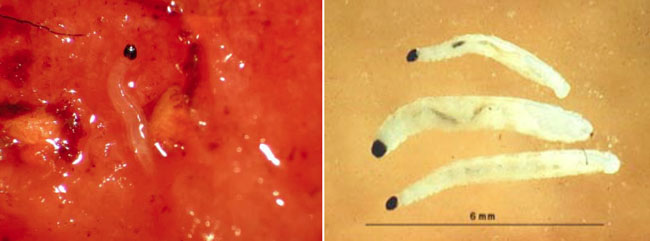
Dark-winged fungus gnat larvae (photos from Univ. of California and North Carolina State Univ.)
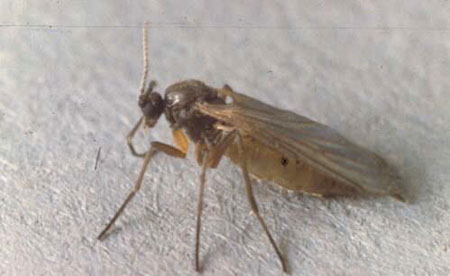
Dark-winged fungus gnat adult (Washington State Univ.).
In mid- to late May I received a call about small larvae in ripe but not rotting strawberries in south-central Illinois. The grower suspected spotted wing Drosophila, but the larvae he saw had distinct heads (“head capsules” in entomology-speak), and Drosophila larvae are maggots without a distinct head (only “mouth hooks” on the narrow front-end of the maggot stage). They were larvae of dark-winged fungus gnats, and I held some infested berries in the lab for adult emergence. This week adult dark-winged fungus gnats emerged. Infested berries were not rotting, and in fact the initial detection of larvae was in fruit otherwise ready for sale. The infested area had been irrigated for frost protection in April, perhaps producing conditions conducive to egg-laying by adults, and it appears that larvae moved from remaining straw mulch and soil surface organic matter up into ripening berries. The only other report of this that I’ve seen is from greenhouse strawberries in southern California in 2011.
Rick Weinzierl (217-244-2126; weinzier@illinois.edu)
Nutrient Deficiency in Fruit Trees
Spring and summer seasons bring about heavy demand for nutrients by newly developing leaves, flowers, fruits, and roots. Nutrients such as nitrogen, phosphorous, potassium, boron, zinc, magnesium, and sulfur are needed to form amino acids, proteins, and structural components of cells. Most fruit trees show visible symptoms for a particular nutrient deficiency long after the damage to their internal structures has occurred. The most difficult task is to identify nutrient deficiencies before they become visible. An effective strategy is to routinely test soil and leaf samples from each block for their nutrient levels. Ideally, a soil nutrient test should be done before planting and every three years thereafter, followed by annual leaf testing after the trees have been established. Minimally, however, each block should be soil-tested every four years and leaf-tested every two years. Based on information gathered from these tests, a base-line level for each of these nutrients can be established. Deviation from this baseline indicates that a corrective treatment needs to be taken. Deficiencies of most nutrients happen over a period of time, and that is why a single test is not very informative. Often changes in soil pH will cause plants to show deficiency in a particular nutrient, even though it is abundant in the soil. A simple pH adjustment to the soil may lead to correcting the problem.
The following are visual descriptions of some of the nutrient symptoms on fruit trees. These descriptions are meant to help you get a general idea of the deficiencies of each element, but they are in no way an accurate assessment of the nutrient status of a particular block of trees, which can only be done through sending samples for analysis. Some analytical laboratories provide recommendations as to what you should do to correct a problem, while others provide a scale of low, adequate, and high based on a general rule of thumb. Fruit trees vary in their nutrient needs and respond differently to different levels. It is best that you examine the results very carefully and not make a quick judgment. For example, some crops such as plum and apricots respond to phosphorous treatment, while others such as grapes show very little response. You also need to determine the method of application. In many situations it is best to apply a needed nutrient in a spray form rather than broadcast because of their poor mobility or because you want to correct the problem in the quickest time possible. Also, it is best not to use fertilizers that have multiple nutrients to correct multiple deficiencies; instead apply each nutrient separately as needed.
Nutrients can be divided into two groups, macro and micro nutrients. Macro nutrients are nutrients that are needed by the trees in larger quantities such as nitrogen, phosphorus and potassium. Micro nutrients are need in much smaller quantities. However, both are equally important for maintain the tree health.
Nitrogen deficiency. Except in peaches, nitrogen deficiency is not a serious problem in old trees in Illinois. However, young trees deficient in nitrogen will have thin and short shoot growth with small and light green leaves. In severe cases, old trees will drop a large percentage of their leaves in late summer and early fall and any leaves that remain will turn red especially around the vein area. Trees with nitrogen deficiency can be identified from a distance by looking for a light colored (pale yellow) canopy that is different from another block of a similar cultivar. However, be aware that some cultivars will have a lighter leaf color than others. For example, ‘Golden Delicious’ leaves tend to be lighter in color than ‘Red Delicious’ leaves. Peach trees show nitrogen symptoms more quickly than apple trees, and that is why it is recommend to apply at least one pound of actual N per tree divided into two applications. Peach trees remove about 68 pounds of nitrogen per acre per year. Apple trees remove about a half of that amount. Calcium nitrate is a better source of nitrogen for fruit trees because it combines two important elements; calcium and nitrogen. Avoid using nitrogen on bearing trees after the fourth cover because it affects fruit color. Fruits exposed to high nitrogen after the fourth cover will be greener in color, have low sugar content, and don’t keep well in storage.
Potassium deficiency. Potassium deficiency is characterized by brown discoloration of the leaf margins and tips and short and thin shoot growth. Potassium deficiency is not a serious problem in Illinois, although it may occur in light or poorly drained soils. It can also occur in old orchards. Mature apple trees can take up to about 86 pounds of potassium per acre, while peach trees can take up to about 60 pound per acre. Although soil testing may identify deficiency, it is recommended that you base corrective treatments on tissue testing rather than soil testing.
Phosphorus deficiency. Phosphorus deficiency is very rare in Illinois. Most fruit trees and vines take enough phosphorous from the soil. Phosphorus exists in the soil as insoluble compounds with iron and aluminum at low pH and with calcium at high pH. Upon contact with the soil, phosphorus fertilizer is rapidly converted into these compounds. Plants take up phosphorus in the form of the orthophosphate anion (H2PO4-). Phosphorous deficiency occurs only under extremely low pH (< 4.0). Trees deficient in phosphorous have grey-looking leaves and stems. The leaves are usually smaller is size and the buds may die in severe cases. Phosphorus has limited influence on fruit quality, although a few believe that it enhances fruit finish, but there is no scientific evidence that I am aware of to support it. Apple and peach trees remove about 10 pounds of phosphorus per acre per year.
Magnesium deficiency. Symptoms of low magnesium include yellowing and scorching of the leaf blades, especially between the veins that can extend to the outer edges. Older leaves tend to fall, while younger leaves hang on, leaving lower areas of shoots bare as seen in the picture above. Fruit quality and yield are not affected by magnesium. Some orchards in Illinois, especially those in the central and northern part of the state, may be considered moderately deficient in magnesium. The symptoms usually occur in the lower leaves on the shoot and extend to the upper leaves. Magnesium deficiency occurs rapidly in acidic sandy soils with low organic matter or in heavily limed soils, especially during the summer months. Excessive potassium fertilization on such soils can compound the problem. Correction of magnesium deficiency may be accomplished post-planting with dolomitic limestone soil applications or after midseason with magnesium sulfate (Epsom Salt) foliar sprays.

Magnesium deficient apple leaves and a tree severely deficient in Mg. Notice the loss of older leaves on the twigs.
Zinc deficiency. Zinc deficiency causes young leaves to bunch together forming a rosette. The leaves tend to be narrow with irregular yellow stripes between the veins. Shoot dieback and high flower bud mortality may also result from severe zinc deficiency. Leaves vary significantly in their zinc level and that is why it is difficult to predict if they are deficient based on nutrient analysis. Visible symptoms are a better indicator of zinc deficiency.
Manganese deficiency. Manganese deficiency results in in formation of yellow mottled leaves. The yellowing, however, is not as intense as with iron deficiency. The deficiency is more severe in alkaline soils. Manganese deficiency is not a problem in Illinois.
Molybdenum deficiency. Molybdenum deficiency is a problem in some Illinois orchards that have very acidic soils. Molybdenum deficient leaves tend to be pale yellow and distorted.
Boron deficiency. Boron is one of the most important microelement for fruit trees, especially apples and plums. Boron deficiency causes poor fruit set due to shortening of the life of the stigma. It causes cork spots, which can be very severe on apples and plums and can cause growing tip-die back, shortened stems and distortion of the leaves. In some years boron deficiency can cause a bumpy fruit skin. The deficiency is a serious problem in many orchards in Illinois. Soils deficient in boron are not restricted to one region in the state, but seem to depend on location and size of the crop. Boron deficiency tends to be serious in years when the crop is heavy or when there is heavy rainfall, especially in early spring. Corrective treatments should be based on leaf analysis, although a soil test is also a good indicator. Boron treatment should be made when previous year leaf analysis show less than 35 ppm or when there is extensive winter injury. It should be done in late fall as a soil application or in early spring as a foliar spray. Boron application after the third cover spray may cause abnormal ripening and internal discoloration of fruit flesh. Excessive boron application to young trees can kill them, for this reason it is best not to apply boron to trees that have not started to produce fruits.
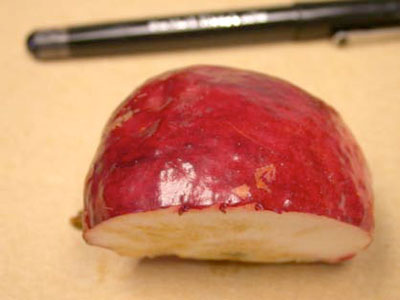
Skin surface of a boron-deficient apple fruit.
Calcium deficiency. Calcium is the most important element for fruit trees. Calcium deficiency can cause poor fruit quality, it can restrict root growth, and causes die-back of growing points. Calcium deficiency is common in acid soils, in seasons of heavy rain, in soils with very high magnesium and potassium levels, and under very dry conditions.
Soil pH and micronutrients deficiency. Most nutrient deficiencies are linked to poor soil pH. For example high soil pH leads to zinc, copper, manganese, and iron deficiencies, while low soil pH can lead to manganese, aluminum, calcium, molybdenum deficiencies.
Mosbah Kushad (217-244-5691; kushad@illinois.edu)
HACCP and GAP
Most of you have started to inspect picking buckets and bins, cider making equipment, and produce sales areas to make sure that everything is in order. Two critical things that you should not forget to review in detail are your GAP and HACCP plans. I realize that many direct-market operations in Illinois are exempt from federally mandated food safety laws, but that exemption does not exclude anyone from being liable in case someone gets sick from eating produce purchased at their farm. A gentle reminder is to think about what had happened to the Jensen’s Farm in Colorado last year. Lives were lost because someone forgot to pay attention to safety details. The following are a few paragraphs that are intended to provide general guidelines on how to streamline GAP and HACCP in your operation.
- Precisely review your farm operation from A to Z, even if you did so last year. Preferably, write down in detail all the steps that you are going through to produce each crop. Identify areas of great risk for contamination. Make note of anything that has changed from last year. Find out if there are any risks from those changes and outline the steps that you plan to take to prevent or minimize the new risk. Also, go over regular steps in your production system. For example, has the irrigation and cleaning water been tested and what were the results? Do you have a plan to correct problems arising from water contamination?
- Assign a lead person in your operation to train workers to follow your GAP plan and make sure that the supervisors are on top of the safety plan in all phases of production, postharvest handling, and marketing steps. Have a contingency plan in case the lead person is not available.
- Remember, doing an excellent job reviewing all the safety steps is not a guarantee that they will be followed or corrected. Make sure to involve everyone in your operation in the review process and assign tasks to those that are responsible for implementing the safety plan. Most importantly, make sure to review your safety plan more than once during the production season and/or if you suspect that there is a lapse in following the plan.
- Make sure that the workers are formally trained to follow the plan through a sit-down meeting and a walk through demonstration of all the steps. Do not assume that they know and therefor there is no need to tell them. I have seen U of I professors and waiters at fast food joints that didn’t wash their hands after they visited the bathroom. Most contaminations occur because someone forgot to follow common sense steps that are the basis of GAP. One way to do it is to have a short gathering of your workers every morning to remind them of food safety and remind them to be vigilant in following the GAP plan. There is a saying in the Middle East “Repetition Teaches Discipline.” If you notice that a worker is careless about food safety, remind him or her of the danger to the customer and the risk to your business. Keep them under surveillance until you make sure that they follow through. If that does not help, then find someone else.
- A HACCP plan is a part of GAP if you plan to produce cider, cook food/donuts, or have a BBQ for sale to customers. I know many of you will not have enough fruits to press for cider this year. However, for those of you that plan to produce cider, but do not have a HACCP plan, let me know. A HACCP pan is needed regardless of whether you pasteurize the cider or not. First, familiarize yourself with the seven steps of HACCP, identify areas of greatest risk in you cider operation, and call me to help you develop a plan. HACCP is simpler than GAP and easier to follow, but it requires constant monitoring and documentation.
Mosbah Kushad (217-244-5691; kushad@illinois.edu)
Notes on Oriental Fruit Moth and Codling Moth
Oriental fruit moth second generation flight should be waning in southern Illinois and peaking in the central part of the state. Second-generation flight has been very light at the University of Illinois orchard at Urbana.
Codling moth: Degree-day accumulations based on a 50-degree F developmental threshold are summarized below, along with estimates of the status of this insect at locations ranging from southern to northern Illinois.
Codling Moth | ||||
|---|---|---|---|---|
Location |
Biofix Date |
Degree-days (base 50 F) from biofix through June 6 |
Degree-days (base 50 F) estimated through June 13 |
Degree-days (base 50 F) estimated through June 20 |
Carbondale |
March 30 |
1074 |
1224 |
1392 |
Belleville |
March 25 |
1101 |
1245 |
1408 |
Urbana |
April 25 |
726 |
867 |
1032 |
Woodstock |
May 10 |
440 |
569 |
721 |
Some reference points for degree-days and codling moth development ...
- At 500 DD, first-generation flight is 90 percent complete, and egg hatch is 54 percent complete.
- At 800 DD, first generation flight is 100 percent complete, and egg hatch is 95 percent complete.
- At 1,000 DD, second-generation flight is 5 percent complete.
- At 1,100 DD, second generation flight is 13 percent complete, and egg hatch is just beginning.
- At 1,400 DD, second generation flight is 60 percent complete, and egg hatch is 21 percent complete.
Rick Weinzierl (217-244-2126; weinzier@illinois.edu)
Vegetable Production and Pest Management
Beet leafhopper in horseradish
Rob Gerstenecker has reported the presence of beet leafhopper in horseradish fields throughout the production region in southwestern Illinois adjacent to the Missouri border near St. Louis. This insect is the vector of the pathogen that causes brittleroot. This is one of the cases where vector control is important for disease control, and insecticide application is recommended where beet leafhoppers are common.
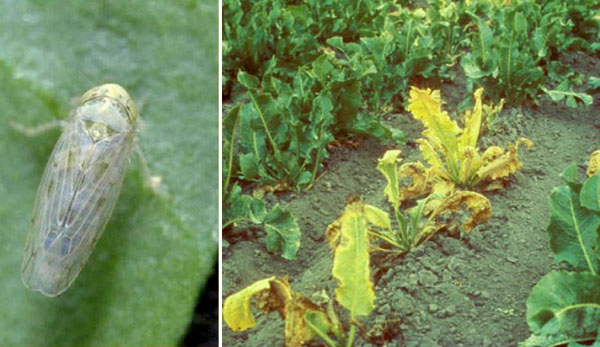
Beet leafhopper (Colorado State Univ.) and brittleroot symptoms (Dan Sherrod).
Rick Weinzierl (217-244-2126; weinzier@illinois.edu)
June MarketMaker Newsletter
The June issue of the MarketMaker Newsletter is now available. Contents of this issue include ...
- Know Your Farmer, Know Your Food & MarketMaker Impact Ethnic Foods
- Top 10 Most View Businesses and Tips to Get Your Business on the List
- Facebook Testimonial
- Take FoodSearcher.com on Vacation
- MarketMaker Buy & Sell Forum ads
Lori Dalfonso (309-792-2577; dalfonso@illinois.edu)
University of Illinois Extension Specialists in Fruit and Vegetable Production & Pest Management
Extension Educators – Local Food Systems and Small Farms |
||
Bronwyn Aly, Gallatin, Hamilton, Hardin, Pope, Saline, and White counties |
618-382-2662 |
|
Katie Bell, Franklin, Jackson, Perry, Randolph, & Williamson counties |
618-687-1727 |
|
Sarah Farley, Lake & McHenry counties |
847-223-8627 |
|
Nick Frillman, Woodford, Livingston, & McLean counties |
309-663-8306 |
|
Laurie George, Bond, Clinton, Jefferson, Marion, & Washington counties |
618-548-1446 |
|
Zachary Grant, Cook County | 708-679-6889 | |
Doug Gucker, DeWitt, Macon, and Piatt counties |
217-877-6042 |
|
Erin Harper, Champaign, Ford, Iroquois, and Vermillion counties |
217-333-7672 |
|
Grace Margherio, Jackie Joyner-Kersee Center, St. Clair County |
217-244-3547 |
|
Grant McCarty, Jo Daviess, Stephenson, and Winnebago counties |
815-235-4125 |
|
Katie Parker, Adams, Brown, Hancock, Pike and Schuyler counties |
217-223-8380 |
|
Kathryn Pereira, Cook County |
773-233-2900 |
|
James Theuri, Grundy, Kankakee, and Will counties |
815-933-8337 |
|
Extension Educators – Horticulture |
||
Chris Enroth, Henderson, Knox, McDonough, and Warren counties |
309-837-3939 |
|
Richard Hentschel, DuPage, Kane, and Kendall counties |
630-584-6166 |
|
Andrew Holsinger, Christian, Jersey, Macoupin, & Montgomery counties |
217-532-3941 |
|
Extension Educators - Commercial Agriculture |
||
Elizabeth Wahle, Fruit & Vegetable Production |
618-344-4230 |
|
Nathan Johanning, Madison, Monroe & St. Clair counties |
618-939-3434 |
|
Campus-based Extension Specialists |
||
Kacie Athey, Entomology |
217-244-9916 |
|
Mohammad Babadoost, Plant Pathology |
217-333-1523 |
|